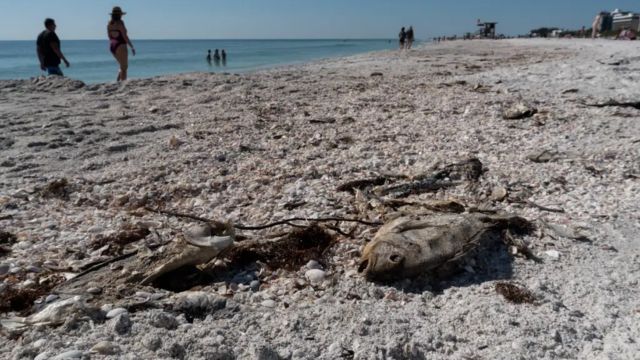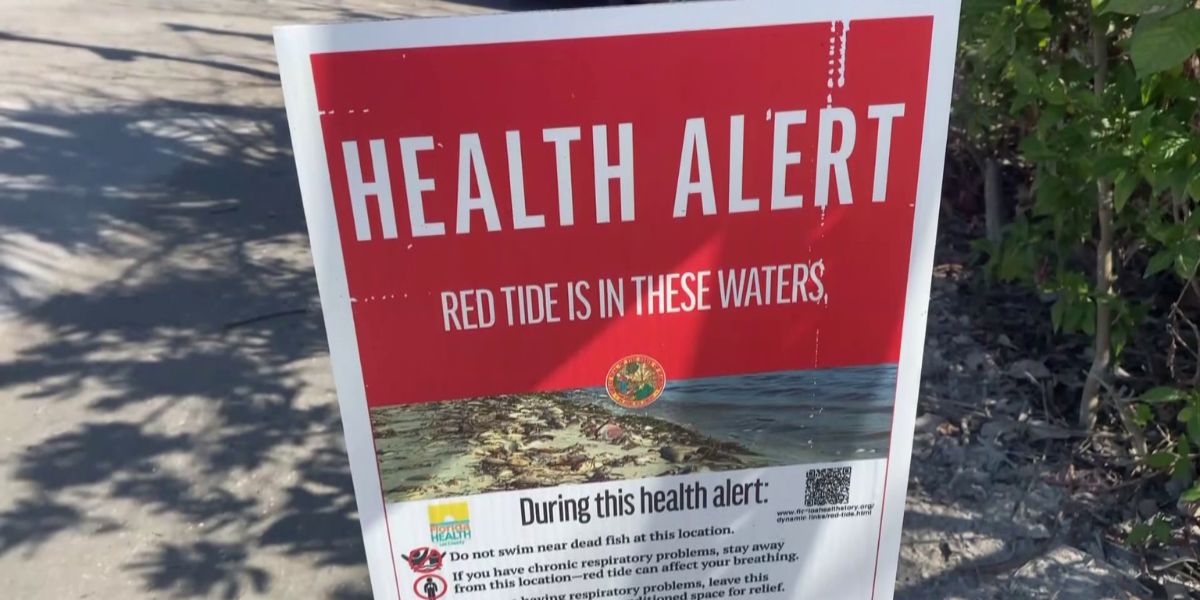Numerous well-known beaches in Southwest Florida are currently under health alerts due to a massive red tide bloom in the Gulf of Mexico.
At least 75 samples collected from along the Gulf Coast, especially after the effects of hurricanes Helene and Milton in 2024, have shown evidence of red tide, which is caused by the organism Karenia brevis.
Widespread warnings have been issued after the toxin-producing algae was discovered and reported by the Florida Fish and Wildlife Conservation Commission.
Although Lee County beaches are currently under health advisories, broad warnings are in effect from the Tampa area to the Florida Keys.
“The public should exercise caution in and around these areas,” the Florida Department of Health in Lee County stated. “Do not wade or swim in or around red tide. Red tide can cause skin irritation, rashes, and burning/sore eyes. Wash your skin and clothing with soap and fresh water if you have had recent contact with red tide, especially if your skin is easily irritated.”
While such situations are not surprising, officials think the red tide bloom is still growing.
Since the hurricanes moved through, NOAA satellites have been monitoring high water chlorophyll levels, which are frequently an indication of high biological activity. Strong tropical cyclones, such as hurricanes Helene and Milton, can mix seawater vertically, which encourages more photosynthesis in the ocean, according to the U.S. Department of Energy’s Office of Science.
Algal blooms are the result of this biological activity, and depending on the species involved, they can have both beneficial and detrimental impacts.

Because of its possible effects on local ecosystems and public health, the present bloom is especially concerning. Because red tide toxins can build up in shellfish and result in foodborne illnesses, local authorities have warned against harvesting shellfish in the impacted areas.
Red tide is directly responsible for the fish kills that have already been observed in Sarasota, Lee, Collier, and Monroe counties. It is well known that the poisonous algae disturbs marine life, causing widespread fish and other organism deaths.
The red tide bloom is predicted to move farther south, from west-central Florida to the Keys, as air temperatures rise. Concerns over possible respiratory impacts for residents or visitors to impacted areas have been voiced by the American Lung Association.
Shortness of breath, runny nose, wheezing, coughing, and sneezing are some of the symptoms that might result from exposure to the toxins that the red tide releases.
Cognitive deficits have been associated with red tide in more severe cases, though these symptoms usually go away as exposure to the chemicals is decreased. Antihistamines sold over-the-counter are frequently used to treat these symptoms.
Although experts have not yet established the duration of the red tide bloom, they do point out that elements like ocean currents and nutrient availability have an impact on the event.
Residents in Lee County who live close to the highest red tide concentrations are advised by the Florida Department of Health to close their windows and use air conditioners as a precaution to improve ventilation and lower exposure to airborne pollutants.
Kansas Passes Historic Bill Prohibiting Gender-Affirming Care for Minors
A reminder of the intricate relationships between meteorological phenomena and coastal ecosystems, as well as the possible hazards to human health and marine life, is provided by the current red tide scenario.




